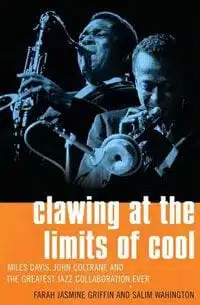
During the 1950s and ’60s, Miles Davis reinvented jazz several times over while maintaining an aura of implacable cool; meanwhile, John Coltrane embarked on an intense spiritual-musical quest, in the process creating music that was both deeply personal and universally resonant. The recordings the two men created together during the period in which Coltrane served as a sideman in Davis’ quintets are among the most important in the history of jazz, and in a their new book, Clawing at the Limits of Cool, authors Farah Jasmine Griffin and Salim Washington argue that Davis and Coltrane’s collaborations also embodied important ideas about what it meant to be a black artist during the Civil Rights era.
“Like the everyday people who valiantly waged the civil rights struggle,” Griffin and Washington write, “the music [of Davis and Coltrane] was dignified and well presented even though it held the hint of rage and turmoil underneath.” By insisting on the legitimate cultural value of their work, Coltrane and Davis challenged dominant images of black musicians as merely entertainers, earning the respect of blacks and whites alike for their accomplishments as artists.
Both Coltrane and Davis grew up in middle class families during the Depression, and to their credit, Griffin and Washington pay serious attention to questions of how this background might have shaped their personalities and worldviews. The authors trace Davis’ deep-running self-assurance to the examples set by his proud parents and grandparents, portraying Davis as the son of a family whose members remained prosperous and proud even in the face of the constant threat of violence from whites who did not approve of their success.
In Coltrane’s case, the authors point not only to the influence of his grandfathers—who were both preachers and community leaders—but also to that of his mother, grandmother, and (later) his wives. Coltrane spent much of his life in the company of strong women, all of whom supported him in his ambitions and played significant roles in making it possible for him to pursue his music seriously.
Most biographers portray Coltrane’s ascent from an anonymous R&B player to a jazz deity as purely a matter of extraordinary discipline—but Griffin and Washington point out that Coltrane would not have been able to so fully devote himself to his art if he hadn’t been bolstered by the material and emotional support of the women who loved and cared for him.
But it wasn’t only family background that shaped Coltrane and Davis—they also significantly influenced each other. The bulk of Clawing at the Limits of Cool closely examines the music of Davis and Coltrane’s collaborations in Davis’ quintets, tracing not only the familiar story of Coltrane growing from apprentice to master under Davis’ tutelage, but also making a case that his sweet and spare playing would sometimes take on a Coltrane-like density and range in response to his sideman’s playing.
Though Griffin and Washington’s close reading of the recorded output of the Davis/Coltrane bands is often nuanced and insightful, there’s not really a great deal of room for them to add much of significance to the already-rich critical discourse on the music of Davis and Coltrane. Instead, the greatest strength of their book comes in their perceptive analysis of the cultural meanings of the public images projected by both musicians.
The authors note that Davis’ cool persona signified a great deal more than just fashionability and hipness. Of Davis, they write, “His personal affect was direct and pointed; there were no gratuitous smiles or any of the pretenses of the entertainer. Miles’ manner seemed to say, ‘The coon show is officially over; we are here to play.”
Miles’ cool was a means of demonstrating his seriousness of purpose; because the image he cut was so forceful and compelling, it became extremely difficult for racist critics to dismiss him as nothing more than a pandering entertainer (as many black artists had been dismissed before him). Coltrane, on the other hand, had a very different persona: instead of affecting hipness, he maintained a quiet dignity, and eventually came to approach his music with the intense and passionate dedication of a spiritual devotee. But much like Davis, he resisted any impulse to stagecraft, and refused to play to the crowd.
Both men believed in the power and importance of their art, and would not to compromise their goals or values in order to meet the expectations of their audiences. As a result, both Davis and Coltrane helped create the cultural environment in which their music could be properly appreciated. Miles Davis and John Coltrane not only created great music, but also taught the world how to listen.
